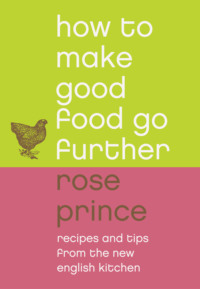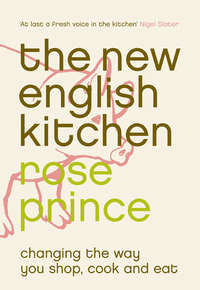
Полная версия
The Savvy Shopper
Eating meat is a big deal, and much respect is due to an animal that has been reared for food. With the emphasis on plentiful and cheap – a mantra followed in food supply for the last 50 years – the welfare of animals has somehow become unimportant to those who eat them. We have picked up some nasty habits: eating only the fillets and prime cuts as if the rest of the animal did not exist; eating a burger or chicken breast a day for just a few pennies; but, worst of all, a lack of curiosity. No one asks, so nothing changes.
Over the last decade, much time has been invested in debating how a fox should be killed, yet the majority of chickens we eat eke out their wretched existence in a broiler house, in conditions that should shame meat eaters. And animal welfare is a problem for vegetarians, too. Milk and egg production still see some of the cruellest practice in the food business. Dairy cows can spend their entire lives being unable to graze, going through lactation after lactation with all the inherent health problems that such a system can create.
Just a few questions when shopping for meat will make an enormous difference. There is much that shoppers can and should ask butchers and retailers before they buy. That is how free-range eggs found their way into supermarkets.
Finally it is worth bearing in mind that British animal welfare standards, while not good enough in the intensive farming sector, are still a vast improvement on welfare standards in Europe and elsewhere.
Country of origin
When shopping, keep one labelling legal loophole to the front of your mind: if a food has been grown or reared in, say, Holland but packed or processed in the UK, it can call itself British. So a side of pork that is cured in Holland and then packed in Britain is British bacon. EU competition laws prevent the real truth coming out on the pack, but responsible shops will often stick a Union Jack or recognisable British mark on the pack. Having said that, plenty of imported meat slips into ready meals and is never labelled as such. This matters mainly because animal welfare systems are even worse abroad than here, and some practices are still legal in other countries – even in EU member states – when they are banned in the UK. Food manufacturers do not always have to state the country of origin for fresh or processed foods, except in the case of controversial foods such as beef. The rule of thumb is this: if the country of origin is not stated, the food is probably not British. This is particularly so with fresh fruit and vegetables. Apples are plastered with Union Jacks when British are in season: otherwise they tend to be sold just as ‘apples’.
The free market and fair trade
Love it or hate it, the Western world is more or less open to trade, although the term free trade is an interesting two-way street, with different rules in each carriageway. Whether free trade is right or wrong, one thing is certain: aspects of it are grossly unfair both to us and to exporting countries. We import what are, in our terms, cheap goods with abandon; the exporting countries pay through the nose to do so via export levies.
Aid agencies campaign for trade barriers to be lifted between the West and developing or ‘third’ countries as a cure for poverty. If barriers were lifted on both sides, however, all hell would break loose. Under our current system, the West could ‘get there first’, meaning it would flood the poorer countries’ food supply chains with dumped goods grown under our subsidy system – it already does to an extent – negating the developing countries’ need to grow their own. It would also move in and set up business for export, which would likely make the few, rather than the many, rich.
But if, as aid agencies want, the trade barrier is lifted to favour only the developing countries, then – in terms of food – we may find ourselves unwittingly buying goods made to a standard that would not be permitted in the UK. This is already happening, between the UK and other EU member states, which are permitted to use production methods denied to us for food safety and animal welfare reasons.
British farmers operate under the most stringent food production rules in the world, and yet we are importing food that could not legally be sold if it had been made here. Because the majority of shoppers buy purely on price, lifting trade barriers to allow more cheap imports could spell the end of British farming and food production. Close the free market? No, we would put an end to centuries of culinary curiosity.
This is a case for shoppers to be circumspect about what they buy – and when they buy it. The sensible choice is to support British food production where standards are higher, as with meat; buy into our gluts of fruits and vegetables when they are in – avoiding the cheaper Spanish equivalent sitting beside it; and always buy with a mind to support small food businesses.
The worldwide commodity exchange has been held responsible for some of the appalling poverty among farmers in the developing world. When oversupply pushes prices down, farmers fall quickly into debt. In 1992 the Fairtrade Foundation was formed by CAFOD, Christian Aid, Oxfam, New Consumer, Traidcraft and the World Development Movement. They were later joined by the Women’s Institute. The idea of fair trade is for retailers to deal directly with farmers’ co-operatives or producer groups, committing to a minimum price in spite of supply. The stories emerging about fairly traded foods are encouraging – a case where changing shopping habits has had a positive effect on the lives of Windward Island banana farmers, Rwandan coffee growers and Palestinian olive oil producers. Beware, however, the attempts currently being made by giant food conglomerates to jump on the Fairtrade bandwagon and gain certification for one product while they continue to trade less ethically with the producers of all their other foods.
It’s not wholly offensive to mention in the same breath that it would be nice if some fair trading went on at home. Dairy and other livestock farms will become extinct in the UK unless a fair price is paid for milk by the main dairies and the supermarkets that buy from them. If there were no livestock farms in the UK, we would end up with a landscape that was a mixture between a national park and a weed-infested wilderness, and a diet of 100 per cent imported meat.
The workforce and other people
When travelling around fruit and vegetable farms in the UK, it is impossible to miss the flexible workforce – the pickers and labourers without whom weeding and hand harvesting would be impossible. But it is also clear that the farms that are happy for a journalist to tour their premises and talk to their staff are unlikely to have much to be ashamed of. There are some excellent schemes for students, and in Jersey the relationship between the Madeira workers and the potato growers is good: living conditions are warm, in substantially built cottages, and the families earn enough from January to June to sustain their lives on the island of Madeira during the rest of the year.
But there are gangmasters who break every rule, exploiting the desperation of workers who want a life in Britain. They pay below the minimum wage and operate no limits to working hours. As a shopper, it is difficult to know who picked your carrots. Supermarkets say they try to keep track, but in practice this is hard to do. The new gangmaster laws that came in after the drowning of the cockle pickers at Morecambe Bay in 2004 are yet to be properly tested.
The tragic reality is that the children of today’s farmers are less and less likely to follow their parents into the business; indeed many are actively discouraged by their parents, and the workforce of the future is likely to be more and more made up of immigrant workers who will work for lower wages. The same workers are employed in processing plants and abattoirs, and as usual they are doing the filthy, tedious jobs. So we have a conundrum. We want to buy British, but buying British may encourage poor practice. If there is a solution, it is to seek out the vegetable box scheme or the farm that opens its doors to scrutiny. Food from such places will cost more, so it is a case of eating the cheaper-to-grow produce, choosing seasonally to get the best value from gluts, and perhaps deciding that pulses are going to play a greater part in your diet.
In exporting countries, the workforce question is also a serious matter, along with the wider impact of food production on populations. Poor monitoring of pesticide use is a much greater problem outside the UK and large numbers of people can be affected, including children – and child labour. Water supplies can be hijacked or polluted by unscrupulous industries; land is acquired from tribal populations who have only a few historical rights to it, their natural habitat subsequently flattened to make way for industrial farming. Information about such practice does filter back, however, and shoppers have a chance to boycott foods whose production causes people suffering.
Additives
Artificial additives do not turn up in food because shoppers need them but because the food industry needs them for economic reasons. While it is understandable that manufacturers should want to profit from their business, the liberal use of colourings, flavourings and preservatives has gone too far. Additives are in much of the food targeted at children. They warp the concept of natural taste, inducing ignorance of the real thing. They have been proven to alter behaviour, and some are known allergens.
Additives are divided into various categories. The largest groups are colours, preservatives, antioxidants, sweeteners, emulsifiers, gelling agents, stabilisers and thickeners. Then there is a smaller number each of acids, acidity regulators, anti-caking agents, anti-foaming agents, bulking agents, carriers and carrier solvents, emulsifying salts, firming agents, flavour enhancers, flour treatment agents, glazing agents, humectants, modified starches, packaging gases, propellants, raising agents and sequestrants.
The food industry is preoccupied with using appearance to attract customers, and also with the stability of food and its shelf life. It is unfair to blame only the manufacturers when retailers are after the same thing. Shoppers do not ask, however, for the plethora of innovations that appear on shelves on a daily basis. The food industry will always say it is supplying demand, identifying what shoppers want. I think this is rubbish. Supermarkets in particular have created a demand, identifying a weakness for novelty in bored supermarket shoppers (and especially their children), and have risen to it with some alarming imaginings. ‘Meal solutions’, they call them – but have you ever heard someone say, ‘What I really need is a Thai spiced shepherd’s pie topped with a feta cheese and ginger parsnip mash’?
Ready-made food can be great – if it is made with good-quality ingredients and nothing else. Even a sausage needs no more than salt as a preservative. However, it will have a shorter shelf life, and buying additive-free food means shopping more frequently – although I make good use of a small chest freezer for bread, sausages and baked things.
Additives are listed on labels, either in code as E numbers, with their industry name, or – if permitted – a common name. This can be confusing. For example, a label can show monosodium glutamate, flavour enhancer or E621 – these are all the same additive.
Manufacturers use different names for additives such as monosodium glutamate because they are controversial. Flavour enhancer sounds so great, don’t you think? The flavour of your food has been enhanced. Terrific, you think, just what it needs. But it doesn’t – or it wouldn’t if the manufacturers used ingredients with real flavour. A ready-meal maker’s greatest ambition is to put as much water and other cheap ingredients such as modified maize starch as possible into a recipe, and they get away with it by tipping in salt, flavourings, colour, gelling agents, stabilisers, emulsifiers, in fact anything that will hide the fact that these bulk ingredients have no texture or flavour.
The organic sector uses some additives, although nothing like as many as conventional manufacturers. Under the Soil Association’s standard, organic producers can use 30 additives (the EU permits 35) including gum fillers, emulsifiers, preservatives and one colour (annatto).
There is a gaping discrepancy between parents’ anecdotes about the effect of additives on their children and the constant reassurance from the industry that these additives are non-toxic. But the point is missed. The kind of reactions seen in children to certain colours, flavourings, sweeteners and preservatives are allergic reactions, and food additives are tested only for toxicity. In 2002 a government-sponsored study monitored 277 three-year-olds from the Isle of Wight for the effects of additives, which were given in orange juice along with placebos. Many parents of children given additives reported significant changes in mood and behaviour. The additives tested included the artificial food colourings tartrazine (E102), sunset yellow (E110), carmoisine (E122), and ponceau 4R (E124), plus the preservative sodium benzoate (E211). Test doses were well below the levels permitted in children’s foods and drinks yet still the allergic reaction certain children showed was significant. But while the authorities commissioned another report, insisting this one was inconclusive, it is noticeable that manufacturers have mostly removed the ‘Filthy Five’ from children’s food.
Not all E-numbered additives are bad. Some, such as ascorbic acid (E300), are simply vitamin C. E-numbers are additives approved by the EU and their effects on our bodies vary.
With the exception of the glutamate family (E621–633), flavourings do not need ‘E’ approval. With natural flavouring, this is fine but flavourings fall into three interesting categories:
• Artificial – chemical imitations of real flavours.
• Nature identical – nice euphemism, where the actual chemicals present in real flavours are extracted to make flavourings.
• Natural – real essences and dried flavours.
When shopping, bear the following in mind as you read labels: if a manufacturer has added flavourings and colourings, the other ingredients are substandard. Avoid such foods if you can.
Labels and logos
Read the labels of everything you buy. They tell you nothing and they tell you a lot. When they say little, that says a great deal; missing information is an indication of poor production standards or dubious origins. Ingredients must be listed on labels by law, in descending order of quantity, and most labels also include nutritional information – the place to spot the presence of salt, saturated fat, sugar and sometimes hydrogenated fat.
Logos say something about the food. Watch for the five British organic logos (the Soil Association one is the best known). The Demeter logo indicates biodynamic food – delightful stuff that has been grown in accordance with lunar cycles but which is basically organic. The red Lion Quality mark stamped on eggs means they came from hens that have been vaccinated against salmonella. The Fairtrade logo tells you the producer received a fair price, and the fishy-patterned Marine Stewardship Council (MSC) mark is a sign of fish from a certified sustainable source.
Other logos are more ambiguous in what they say about the food in the pack. The Red Tractor covers a wide range of production assurance but allows for intensive production. The same can be said for ‘Farm Assured’ and the British Quality marks for beef, pork and lamb. LEAF allows pesticide use (though under stricter controls, but I have visited LEAF farms and been impressed with successful schemes boosting wildlife). The RSPCA’s Freedom Food logo indicates a vast improvement in animal welfare in intensive farming, but it does not come anywhere near the Soil Association standard of animal welfare.
I hate logos, but we need them. I would prefer to read an epistle on a label that tells me all there is to know about the food in a pack, linked through to websites with contact details. But none of this would be necessary if shops employed knowledgeable staff and trained them to talk to you about the food they sell.
Retailers
There are four main supermarket chains in the UK: Tesco, Asda, Sainsbury and Morrisons. Then there are smaller chains, such as The Co-op, Waitrose, Budgens and Booths. Much has been said about the buying power of the big chains. This book focuses on how shoppers’ habits can make demands on the retailers, who have no choice but to respond to them.
I sent a detailed questionnaire to the supermarkets, asking how they source or produce most of the foods mentioned in this book. They were given a four-week period in which to reply. Of the Big Four, Morrisons declined to answer shortly after receiving the questionnaire, while Asda did not meet the deadline, pleading time poverty (they were given one month, then a further two months in all). Tesco sent only part of the questionnaire back to me, just inside the extended deadline of three months, again pleading lack of time. That these big retailers cannot put their hands on an up-to-date database in the computer age is an embarrassment on their part. The information should be available, so it appears they chose not to give it. They do have customer service lines (see below), where you can obtain lists of ingredients and sometimes information on the country of origin, but details are hard to obtain from these sources.
The results of the questionnaire are included in most sections and I have tried where possible to mention ethical options sold by supermarkets (e.g. Fairtrade bananas, organic chicken, cod from a sustainable source…). If information from supermarkets who did respond to the questionnaire is missing, it may be because they did not answer clearly or didn’t answer at all.
For up-to-date information about products, the supermarkets can be contacted on the following numbers:
Asda: 0500 100055
Booths: 01772 251701
Budgens: 0870 526002
Co-op: 0800 0686 727
Morrisons: 01924 870 000
Safeway: 01622 712 987
Sainsbury: 0800 636262
Somerfield: 0117 935 9359
Tesco: 0800 5055 5555
Waitrose: 0800 188884
But however many pounds in every ten we spend at Tesco, small shops still exist. Great butcher’s shops, cheese shops, specialist food shops, bakeries, fishmonger’s and even a few greengrocer’s cling on in the high streets – please seek them out. They actually have shop assistants who can talk knowledgeably to you, and may even help carry bags and give cooking advice. Yep, pinch yourself, you’re having a pleasant shopping experience.
Farm shops are my favourite, partly because they make superb meat and just-picked organic produce affordable. No high-street rents and no middle men mean lower prices. And you can take the car – very eco-unfriendly, but you can hardly tramp across fields with your shopping.
Low prices for fresh food are promoted by the supermarkets but before you rush to buy the free-range chicken or English asparagus at Tesco, check the price at your farm shop, butcher’s or local produce stalls. Three experiments carried out by my husband, Dominic Prince, in 2004/2005, in the Evening Standard, the Spectator Magazine and on ‘Tonight with Trevor McDonald’ (ITV), revealed certain prices at the small shops to be up to 40 per cent lower than those at Tesco – a considerable margin.
Online shopping for home-delivered food is another way to buy the best-quality food at the right price. I still find the worldwide web a weird shop. I am unable quite to complete the transaction without phoning the online shop about something quite unnecessary, just to make sure that there are people and not Martians running the place. But mail order is great. Don’t be put off by the home-delivery practicalities. Most online or mail-order companies will organise a delivery time to suit you, or bring it to your office if that helps, or give the delivery to a neighbour or hide it in the garden shed in your absence. Once you have dealt successfully with a home-delivery supplier for the first time, it’s a good idea to add the clause ‘leave unsigned’ to the order, particularly if you have a good hiding place. Small companies are flexible about this, although some will not do it for safety reasons.
The higher price of good food
The cost of naturally reared meat, organic vegetables and good-quality, additive-free ready-made foods will always be higher than budget-priced, intensively produced, additive-heavy foods. One of the most off-putting elements in changing shopping habits, when we are so used to paying less, is the higher price. But by balancing the ratio of luxury foods to cheap, everyday items and finding out how to use cheap cuts of meat, using up leftovers so we don’t waste a thing, and buying into gluts when they are at their cheapest (and most delicious), it is possible to keep the bill close to the old one. This kind of latter-day household management was the subject of my first book, The New English Kitchen (Fourth Estate, 2005). Many of its recipes show how the finest food will fit inside a tight budget. Think twice, for example, before you throw away the chicken carcass. Remember that stock can be made from its bones and used to make a risotto, so in the end it contributes to two meals.
Health, nutrition and functional food
In the past twenty years obesity rates in the UK have trebled, to 20 per cent of adults and 10 per cent of children. The food industry is – rightly – under fire for manufacturing and promoting unhealthy food. The industry responds by saying that, if we all took more exercise, it would not matter that we consume too many fats and sugars. I predict that the industry will wish it had not ignored its responsibility for so long. Some food manufacturers are reducing fat, salt and sugar content in the food they make; a time may even come when we laugh at the way we gave children sugar-coated breakfast cereals, in the same way our parents giggle at how their GP once offered a cigarette during a consultation. The authorities are trying to catch up on the situation, again far too late. The Food Standards Agency’s suggested proposal of a red –amber–green ‘Traffic Light’ warning logo on food was trounced in early 2006 by the announcement that some of the biggest players in the industry plan voluntarily to change the nutritional information on their packaging, giving the RDA (recommended daily allowance) of each particular food. That the daily allowance of any particular food will be decided by the manufacturer is laughable – but it could also be seriously confusing to the consumer.
It may be true that all food is nourishment to a degree, but what we put in our bodies is now a major preoccupation. The food industry – no slouch when it comes to fashion – has responded with ‘functional foods’, foods with added beneficial ingredients, such as pro-biotic yoghurt drinks (said to aid digestion) and chickens with added essential omega-3 fatty acids (for heart and tissue health). Before you throw these things in the trolley, bear in mind that, unlike those made by pharmaceutical companies or even herbal remedies, the health claims on food labelling need not be backed up. The functional food industry is also expecting that these rules will be relaxed further in the near future. Take omega-3: there is no doubt that these fatty acids are heart-healthy, but I’m sorry to say that there is just not enough evidence to prove they boost brain power except in premature babies. The food industry is set to make billions out of gullibility. Nutritionists all say the same thing: stick to eating, or feeding your kids, a varied diet made up of fresh foods, freshly cooked.








